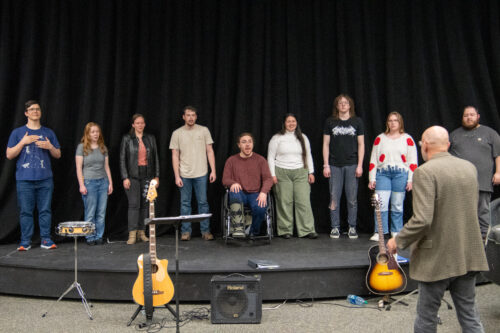PALMER — It could be a win-win for the canine set: Human hikers get a doggy date, while pound pups get the jailbreak they’ve been waiting for.
That, at least, is the idea behind a new Mat-Su Animal Shelter program aimed at pairing adoptable shelter dogs with people who want to borrow them for a few hours.
And if those volunteers end up wanting to keep their temporary trail buddies forever? Shelter officials would never dream of stopping them, said Abi Anspaugh, an assistant shelter manager.
“We want people to find a dog that is perfect for them and have a chance to do that,” she said.
The new program, dubbed Miles and Mutts, connects volunteers with dogs for short day hikes on about a dozen Matanuska-Susitna Borough trails designated as dog-friendly. The program will be available to the public in mid-May, shelter officials said.
:quality(70)/cloudfront-us-east-1.images.arcpublishing.com/adn/6BABN6I4UFA2HCAMF5MZTBXFYM.jpg)
Dogs can be booked for outings by calling the animal shelter or by visiting during open hours after noon on weekends. Before borrowing a dog, volunteers must sign a waiver and attend a brief orientation that includes information on safe dog handling and care, officials said. Volunteers are screened during a one-on-one meeting with shelter staff, they said.
Outing lengths vary and borrowed dogs must remain leashed and returned to the shelter by a designated time, under the new program. Each dog will be fitted with a tracker in the unlikely case of escape, officials said. Participating shelter dogs will be fully vaccinated, microchipped, neutered or spayed, free of major behavior problems like aggression and available for adoption, they said.
Volunteers interested in borrowing a dog can call the shelter to schedule a hike and learn about what dogs are available for adventures, officials said. Children can participate if accompanied by an adult, they said. Volunteers may only take one dog at a time, and family pets must be left at home; poop bags, dog treats and a leash system will be provided, they said.
Miles and Mutts mirrors a popular Doggy Day Out program used by shelters throughout the U.S., including in Valdez, Anspaugh said. Similar programs are offered throughout Hawaii.
Giving potential adopters a chance to spend time with a canine isn’t the only benefit of the program, said shelter manager Jamie Kennedy.
Simply getting outside the shelter gives dogs a chance to socialize away from the sometimes chaotic environment of the shelter, she said. It also gives staff a window into how they might behave in a non-shelter environment, she said. Volunteers are given report cards to rate their borrowed dog’s behavior on everything from car and trail manners to bowel movements. That feedback is then added to the dog’s shelter file and shared with potential adopters.
For shelter dog Marley, a boisterous 9-month-old female Siberian husky, that post-hike report card likely included high marks for joy but low ones for in-car behavior after a recent outing with Cami Banea, a regular shelter volunteer.
Banea drove Marley to the Crevasse-Moraine trail system near Palmer for a short hike Tuesday during a Miles and Mutts program test ahead of next month’s full public rollout.
Marley, who has been at the shelter since her owners dropped her off in late March, spent the drive from the shelter bounding around the car, said Banea. She then sniffed her way down the trail, yanking on her leash over a short, sunny afternoon jaunt.
Banea said she’s been patiently waiting to find the just-right shelter dog since her move to the Palmer area from California late last year. She grabbed Marley for a hike to see if she’s the right candidate but worried the fluffy white dog might be too young to fit what she can handle.
:quality(70)/cloudfront-us-east-1.images.arcpublishing.com/adn/U5JXTGTLSZHUTG73PLU6ILLGWI.jpg)
“I’m an overthinker,” she said. “I’ve never had a dog, and volunteering gives you a chance to get to know them.”
The Miles and Mutts program is one of many efforts by borough animal care officials to adopt out a near-record number of animals in recent years. Other programs include using more foster homes and increasing the number of animals sent for adoption placement through local rescue organizations.
The shelter’s steady influx is caused primarily by economic challenges in the community, a trend seen statewide after the COVID-19 pandemic, said shelter director Chris Loscar.
“We’re seeing just intake rates are increasing, adoption rates are decreasing,” he said. “We’re seeing a lot more owner surrenders because of economic reasons.”
Over the first three months of 2024, the shelter took in 736 animals, including 244 dogs and 116 puppies, Loscar said. The shelter took in 3,486 animals last year and euthanized just over 21% due to illness or behavior issues, officials said.
There were about a dozen dogs available for adoption as of Thursday, according to a shelter adoption website.
Shelter officials recently began enforcing a longstanding law that requires anyone who finds an animal to surrender it to the shelter rather than to one of the region’s animal rescues so they can be accurately added to the shelter’s system. Those animals do not add to crowding because they are typically sent out to rescues after a three- to five-day holding period, Anspaugh said.
The shelter this month temporarily stopped accepting dogs surrendered by owners because it didn’t have enough open kennels to house them plus any incoming strays, Anspaugh said. Adoptable dogs add to shelter crowding because each dog requires so much space, she said.
:quality(70)/cloudfront-us-east-1.images.arcpublishing.com/adn/352IL5JX65FJVP2KSTZGOVBPGY.jpg)
Dogs that participate in the Miles and Mutts programs will be outfitted with bandanas advertising the program, Anspaugh said. So they may end up not only getting adopted but also serving as walking billboards for other dogs who aren’t as lucky yet.
“A great outcome would be drawing other people to the shelter, getting our foot traffic up for other animals in our building,” she said.








:quality(70)/cloudfront-us-east-1.images.arcpublishing.com/adn/LCCPJNUKDFGM3PV4BQBVOMTXTM.jpg)
























